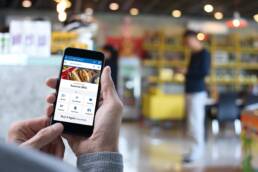ARTICLE
Future of Mobile E-Commerce in Grocery
Mobile shopping has become the norm for many customers, especially Millennials and Gen Z.

Over 90 percent of consumers between the ages of 18 to 39 use a smartphone when shopping, according to data collected in a study by Acosta in 2020. Large segments of Generation X (66%) and Baby Boomers (44%) similarly reported that they feel comfortable using digital tools when grocery shopping, according to the same study.
Mobile apps and mobile-responsive websites have become essential tools for all retailers as consumers continue to prefer shopping “on the go” through their mobile devices. Mobile shopping is a very lucrative channel for grocers and is growing rapidly. Research firm, Incisiv, found that customers using mobile apps view 4.2x more products, spend 6x more time on the app/website, and generate 3x higher conversion rates, versus those using desktops.
How are shoppers using mobile apps?
Now more than ever, shoppers are looking for one platform to accomplish their grocery shopping needs – from browsing for deals, to creating a shopping list, to finally having it delivered at curbside or to their home. Gone are the days of single-use apps as shoppers look to consolidate their digital activities under as few apps as possible. According to eMarketer, 67% of consumers want at least two of their digital activities integrated into one place. So what are they using the grocery app for?
Over 70 percent of shoppers use their grocery retailer’s app to place orders, find products in the store, and participate in loyalty programs (Acosta). Shoppers have also shown interest in other features for grocery apps that create a more complete shopping experience, including recipes and digital coupons.
The opportunity for grocery retailers
Grocery was the fastest growing app category in 2020 (40.9%) and 2021 (5.8%), according to eMarketer. Consumers’ hunger for convenience and the rapid development of grocery e-commerce technology has created an opportunity for grocery retailers to own their customers’ entire shopping cycle.
For years consumers have created their shopping carts from recipes they find online or in cookbooks, gone to the store to shop those products (not knowing if the brand they want is in stock), and brought the groceries home. With mobile app solutions, such as Wynshop Mobile, grocers can enable shoppers to browse recipes, add products directly from the recipe to their shopping carts, notify them if there is a coupon, buy the items, and have them delivered to their home or ready for pick up at their local store.
By consolidating an array of experiences, services, and functions on a single platform that customers already feel confident using, grocery retailers can provide seamless experiences that keep users engaged. Furthermore, by coupling loyalty programs with mobile apps, customers will enjoy the immediate gratification of seeing their loyalty points add up as they shop and retailers can use push notifications to share new promotions and exclusive offers. A mobile app is much more than a sales channel, it is the preferred option for your customers to interact with and manage their relationship with you.
The future of mobile apps in grocery
The future of grocery shopping, both in-store and online, is through mobile devices. Grocers who successfully launch mobile apps and engage with their customers will be at the forefront of the evolving shopping experience in the coming years. One trend, in particular, that is having a major influence on future shopping behaviors and expectations is mobile-first self-checkout options, such as “scan and go” and fully frictionless shopping.
Shoppers don’t want to wait in lines when they go to stores. Self-service Point-of-Sale terminals, a relatively new technology, are already becoming outdated, with wait queues often having similar wait times as their cashier-driven counterparts. Grocery and convenience retailers are starting to integrate Scan-and-Go technology into their mobile apps, and this is a trend that is sure to continue to grow.
Other emerging trends, such as Quick Commerce and Augmented Reality, are mobile-based. The foundation of the future of grocery shopping is mobile applications. Grocers need to take advantage of this opportunity to strengthen their direct relationship with customers and build the foundation that will allow them to serve their customers in a totally new way.


